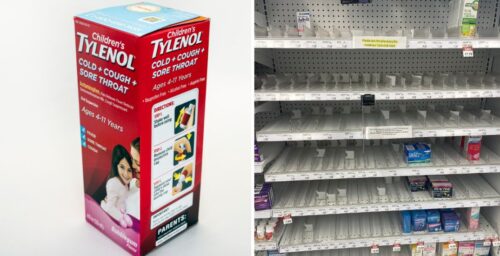If you’re a parent, it’s likely become the norm in the past few months to see empty shelves of children’s pain and fever medications at your local pharmacy.
In early October, Health Canada issued a public advisory confirming ongoing shortages of children’s ibuprofen and acetaminophen in pharmacies and hospitals across the country.
“This shortage is due to unprecedented demand,” the government agency said.
“We recognize this situation is worrying and how important these healthcare products are to families, caregivers and healthcare professionals who rely on them to reduce fever and pain in infants and children.”
The federal government says the problem began in the summer, when supply of children’s acetaminophen (Advil and Motrin) and ibuprofen (Tylenol) couldn’t keep up with demand.
While Health Canada says it is working with manufacturers and suppliers to address the shortage, parents, healthcare professionals and children are dealing with the fallout.
Health Canada is working hand-in-hand with manufacturers and suppliers to explore all opportunities to increase supply to meet demand for children’s paracetamol and ibuprofen products. Learn more: https://t.co/xFb8ikHkyC pic.twitter.com/2TuY6BAhzC
— Health Canada and PHAC (@GovCanHealth) October 7, 2022
From the impact it is having on parents and healthcare professionals, to what government is doing to help, here’s what we know about the shortage.
Why demand exceeds supply
Hospitals across Canada are seeing an influx of children battling respiratory illnesses like the flu, bacterial pneumonia and asthma.
dr Nisha Thampi, a pediatrician, explained how dire the situation is at a children’s hospital in Ottawa.
“The news doesn’t quite capture the intensity of the work at CHEO and the sense of futility as we take on more children [respiratory syncytial virus]Rhinovirus, flu, bacterial pneumonia, asthma,” she wrote in a Twitter thread.
The news doesn’t quite capture the intensity of the work at CHEO and the sense of futility as we take in increasing numbers of children with RSV, rhino, flu, bacterial pneumonia and asthma.
I understand that the signal for public health action is when the acute care system is in crisis.
1/
— Nisha Thampi (@NishaOttawa) November 6, 2022
These diseases rely heavily on drugs like Tylenol to relieve pain or fever in children.
In addition, Canadian packaging regulations require bilingual labeling in English and French. This has prevented Health Canada from importing Tylenol, Advil and Motrin for children from countries like the US.
How parents and healthcare providers are affected
Healthcare providers are overwhelmed with this shortage.
“This is like local Armageddon,” tweeted pharmacist Kristen Watt. “No fever reducers, no antibiotics.”
Since yesterday the back order of amoxicillin was detected, the oral liquid antibiotics azithromycin and cefuroxime are no longer available.
It’s like Armageddon on the spot. No fever reducers, no antibiotics.
How does parenting or healthcare work in this climate?
— Kristen Watt RPh (@PharmacistMama) November 4, 2022
The infectious disease doctor, Dr. Isaac Bogoch, adds hospitals are thinly saturated along with the impact of COVID cases.
Many respiratory viruses are currently circulating in Canada, including COVID, RSV and a growing strain of influenza.
These are affecting all age groups and health care is overwhelmed.
Indoor masks and vaccinations are helping… COVID and influenza vaccines are free and widely available. pic.twitter.com/BDeS4la8pc
— Isaac Bogoch (@BogochIsaac) November 6
Parents have taken to social media to express their exhaustion at the shortage.
“Our child is sick again. Third time in four weeks… we’re lucky my mom brought Tylenol for kids when she visited,” one parent tweeted.
“I can’t imagine what other parents go through without Tylenol or Advil. How are your children doing? This new normal really sucks.”
Our child is sick again. The third time in 4 weeks. High fever, hoarse cough. We’re lucky my mom brought Tylenol for kids when she visited. I can’t imagine what other parents are going through without Tylenol or Advil. How are your children doing? This new normal really sucks. 😣
— Jooyoung Lee🥋 (@theyoungjoo) November 7, 2022
Others are understandably frustrated.
“Hey, HealthCanada. My kid with a bad cough doesn’t give a fuck if his medicine has French on the box. fix this shit Now,” one parent tweeted.
Hello HealthCanada. My kid with a bad cough doesn’t give a fuck if his medicine has French on the box. fix this shit Now pic.twitter.com/vcmdmcKGWF
— Kevin Pacitti 15 🇨🇦🇮🇹🇬🇧 (@kpac_15) November 4, 2022
What the government is doing to help
It seems that Health Canada has finally heard the cry for help from parents and healthcare professionals.
Last week, Canada waived bilingual labeling requirements to bring tens of thousands of children’s pain relievers into the country.
The agency’s chief medical adviser, Dr. Supriya Sharma told The Globe and Mail that Tylenol, Advil and Motrin for children were imported from the US and Australia.
The drug will be sent to hospitals first while the government awaits proposals from drug companies able to ship more products for over-the-counter purchases.
In the meantime, here’s what Health Canada should do if your child is sick and you don’t have access to these products.















